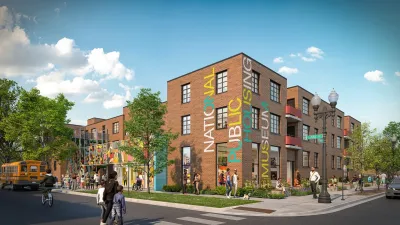Cities across the country are re-utilizing brownfield sites as solar farms.
The contaminated sites would often cost too much to clean up for other reuse, so more and more cities are opting to allow solar power installations.
"In Chicago, Dave Graham, who works on the city's brownfield program, said the City Solar project just "fell into our laps." He was called into a meeting in the mayor's office with representatives from Exelon and SunPower, and found they wanted to create a massive solar farm on a derelict brownfield site. Actually, massive is an understatement for this project: it's the largest urban solar plant in the U.S. Its 32,000 photo voltaic (PV) panels provide 10 MW of energy, enough for 1,500 local homes. In addition, GPS tracking systems help tilt the panels, ensuring the most efficient use of solar energy.
Heavily contaminated sites can cost up to $150,000 per acre to clean up. The West Pullman site for City Solar, which 'has a variety of issues,' would have cost $20 million alone to clean up, 'something no one in the city wanted to invest in.'"
FULL STORY: Cities Use Brownfields to Go Solar

Alabama: Trump Terminates Settlements for Black Communities Harmed By Raw Sewage
Trump deemed the landmark civil rights agreement “illegal DEI and environmental justice policy.”

Planetizen Federal Action Tracker
A weekly monitor of how Trump’s orders and actions are impacting planners and planning in America.

The 120 Year Old Tiny Home Villages That Sheltered San Francisco’s Earthquake Refugees
More than a century ago, San Francisco mobilized to house thousands of residents displaced by the 1906 earthquake. Could their strategy offer a model for the present?

Indy Neighborhood Group Builds Temporary Multi-Use Path
Community members, aided in part by funding from the city, repurposed a vehicle lane to create a protected bike and pedestrian path for the summer season.

Congestion Pricing Drops Holland Tunnel Delays by 65 Percent
New York City’s contentious tolling program has yielded improved traffic and roughly $100 million in revenue for the MTA.

In Both Crashes and Crime, Public Transportation is Far Safer than Driving
Contrary to popular assumptions, public transportation has far lower crash and crime rates than automobile travel. For safer communities, improve and encourage transit travel.
Urban Design for Planners 1: Software Tools
This six-course series explores essential urban design concepts using open source software and equips planners with the tools they need to participate fully in the urban design process.
Planning for Universal Design
Learn the tools for implementing Universal Design in planning regulations.
Clanton & Associates, Inc.
Jessamine County Fiscal Court
Institute for Housing and Urban Development Studies (IHS)
City of Grandview
Harvard GSD Executive Education
Toledo-Lucas County Plan Commissions
Salt Lake City
NYU Wagner Graduate School of Public Service





























